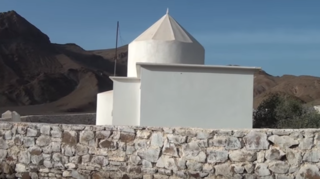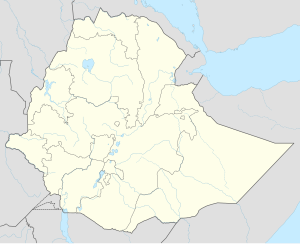Ankober, formerly known as Ankobar, is a town in central Ethiopia. Located in the North Shewa Zone of the Amhara Region, it's perched on the eastern escarpment of the Ethiopian Highlands at an elevation of about 2,465 meters (8,100 ft). It is 40 kilometers (25 mi) to the east of Debre Birhan and about 90 miles (140 km) northeast of Addis Ababa.
Amba Mariam is a village in central Ethiopia. Formerly known as Magdala or Magdalena during the reign of Emperor Tewodros II (1855–1868). Located in the Debub Wollo Zone of the Amhara Region, Amba Mariam has a longitude and latitude of 11°12′N39°17′E.

Johann Ludwig Krapf was a German missionary in East Africa, as well as an explorer, linguist, and traveler. Krapf played an important role in exploring East Africa with Johannes Rebmann. They were the first Europeans to see Mount Kenya with the help of Akamba who dwelled at its slopes and Kilimanjaro. Ludwig Krapf visited Ukambani, the homeland of the Kamba people, in 1849 and again in 1850. He successfully translated the New Testament to the Kamba language. Krapf also played a key role in exploring the East African coastline, especially in Mombasa.

The Issa is a northern Somali clan, a sub-division of the Dir clan family.
Mieso is a woreda in Somali Region, Ethiopia. Part of the Shinile Zone, this woreda is bordered on the south by the Oromia Region, on the northwest by the Afar Region, and on the east by the Afdem woreda. The administrative center for this woreda is Mulu town.
Were Babo is one of the woredas in the Amhara Region of Ethiopia. This woreda is named for one of the "Houses" or subgroups of the Wollo Oromo that used to govern the area and is still located there. Part of the Debub Wollo Zone, Were Babu is bordered on the south by Kalu, on the west by Tehuledere, on the north by the Mille River which separates it from the Semien Wollo Zone, on the east by the Afar Region, and on the southeast by the Mio River which separates it from the Oromia Zone. The administrative center of Were Babu is Bistima; other towns include Ejersa, Arabati and Bokeksa.
Legambo is a woreda in Amhara Region, Ethiopia. This woreda is named for one of the "Houses" or subgroups of the Bete Amhara, who were located there. Part of the Debub Wollo Zone, Legambo is bordered on the south by Legahida and Kelala, on the southwest by Wegde, on the west by Debre Sina, on the northwest by Sayint, on the north by Tenta, on the northeast by Dessie Zuria, and on the southeast by Were Ilu. Towns in Legambo include Aqesta and Embacheber.
Moretna Jeru is one of the woredas in the Amhara Region of Ethiopia. It is named in part after the historic district of Shewa, Moret, which lay between the Jamma River and the district of Shewa Meda. Part of the Semien Shewa Zone, Moretna Jeru is bordered on the south by Siyadebrina Wayu, on the south west by Ensaro, on the northwest by Merhabiete, on the northeast by Menz Keya Gebreal, and on the east by Basona Werana. The administrative center of this woreda is Enewari; other towns in Moretna Jeru include Jihur.
Minjarna Shenkora, also Menjarna Shenkora is a woreda in the Amhara Region, Ethiopia. It is named in part after the historic Shewan district of Minjar, which was the southernmost district of Shewa and near the location of the modern woreda. Located at the southern end of the Semien Shewa Zone, Minjarna Shenkora is bordered on the east, south and west by the Oromia Region, on the northwest by Hagere Mariamna Kesem, and on the northeast by Berehet; the Germama river forms the boundary between this woreda and Hagere Mariamna Kesem and Berehet. The administrative center of this woreda is Arerti; other towns in the woreda include Balchi and Eranbuti.
Meta Robi is one of the Aanaas in the Oromia region of Ethiopia. Part of the West Shewa Zone, it is bordered on the south by Ejerie, on the southwest by Jeldu, on the northwest by Ginde Beret, on the north by the Muger River, and on the east by Adda Berga. The major town in Meta Robi is Shino.
Sela Dingay is a town in central Ethiopia. In Amharic the name means the sharpened stone, named for a rock which rolled over the edge of the southern rim of the gorge of the Mofar River, and killed a group of people sitting on it. Located in the Semien Shewa Zone of the Amhara Region, this town has a latitude and longitude of 09°58′N39°38′E with elevations variously given as 2880 and 2915 meters above sea level. It is the administrative center of Mojana Wadera woreda.
Ambabbo is a village in eastern Djibouti. It is located in the region of Tadjoura.
Tenta is a town in northern Ethiopia. Located in the Debub Wollo Zone of the Amhara Region, Tenta has a latitude and longitude of 11°19′N39°15′E with an elevation of 2,972 meters (9,751 ft) above sea level. It is one of three towns in Tenta woreda.

Borkana River is a river of central Ethiopia. A left tributary of the Awash. Johann Ludwig Krapf records that it was called "Tshaffa" by the local Oromo people.
Qechene River is a river of central Ethiopia. It rises near Aiamsa in the Annas Mountains, and flows to the west to join the Wanchet. The watercourse's tributaries include the Ketama and Woia. According to Johann Ludwig Krapf, the Qechene defines the boundary between the Shewan districts of Gishe and Menz.
The Journals of the Rev. Messrs. Isenberg and Krapf, Missionaries of the Church Missionary Society, Detailing their proceedings in the kingdom of Shoa, and journeys in other parts of Abyssinia, in the years 1839, 1840, 1841 and 1842 is a journal published in 1843 at London. It contains the geographical memoir of the eastern part of the continent Africa, and most day by day events that took place in the original time of their happening. It is associated with the missionary works of Carl Wilhelm Isenberg and Johann Ludwig Krapf of the Church Missionary Society, and their encounter with the yet poorly known kingdom of Shewa in Ethiopia.
Crawleyville is an unincorporated community located along the Wabash River in Wabash Township in Gibson County. In the early 1900s, Crawleyville was an active community of farmers and fishermen.
Marra Biete is a former province of Ethiopia, located inside the boundaries of the modern Semien Shewa Zone of the Amhara Region, north of Shewa Meda.
Ancharo also known as Curcureta is a town in northern Ethiopia. Located in the Debub Wollo Zone of the Amhara Region, Ancharo has a latitude and longitude of 11°03′N39°47′E with an elevation of 2972 meters above sea level. It is one of four towns in Kalu woreda.
Karl Wilhelm Isenberg, spelt or known by names Carl Wilhelm Isenberg or Charles William Isenberg or C. W. Isenberg or Carl W. Isenberg or Charles Isenberg, was a German Church Missionary Society missionary and linguist to East Africa and Western India.



